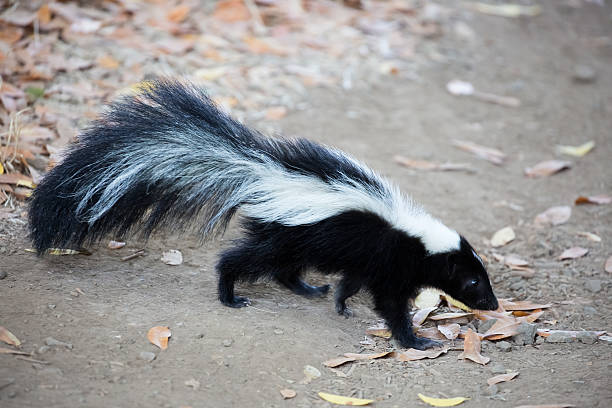Hooded skunks are a variation of the stinky yet relatively harmless striped creatures that roam the wilds of North America. They can be found in suburbs, open grasslands, forests, and near bodies of water. Occasionally, you may even spot a hooded skunk near the boundaries of an urban epicenter, but the likelihood of them stepping inside is little to none. Find out more about the life of the hooded skunk and what to do if you require skunk removal in Whitby this season.
How To Spot a Hooded Skunk?
Hooded skunks look similar to their cousins, the striped skunk, famously portrayed by Pepe Le Pew on the Looney Tunes cartoons of years past. The animated and amorous French-inspired skunk does not carry many other likenesses to the actual mammals in North America.
Hooded skunks are typically the size of a large cat and have a more pronounced white section of fur down their backs and onto a long tail. Rather than a stripe, the white coat covers the top of the head and the back like a cloak or a hood to help identify them as a separate species. Despite their name, the hooded skunk will go through three different stages and colours of fur in their lives. The three stages include:
- White-backed
- Black-backed
- All-black
Where Can You Find a Hooded Skunk?
Hooded skunks are notorious for toddling through grasslands and forest floors near bodies of water to find bountiful food. However, during arid months, skunks are also likely to come into suburban areas that border their habitats to seek food and housing. In rare cases, typically when something is wrong, a skunk will wade into an urban area, though the foray usually does not end well.
What Do Hooded Skunks Eat?
Hooded skunks, like all skunks, are omnivores, which means they eat both plants and meat. Skunks are polite guests who will eat anything provided or easily accessible to them, including chicken eggs, bugs, trash, fish, and fruit. A particular favourite of the hooded skunk is the prickly pear.
What Is the Lifespan of the Hooded Skunk?
The hooded skunk reproduces with several mates throughout its life and typically lives in a community of other skunks. Like all mammals, the hooded skunk gives birth to live babies; the young ones are called kits. As different members of the den or community hunt and protect the others, the females primarily rear the kits until they reach maturity. This variation of skunk will live to anywhere from 3 to 5 years of age and occasionally longer, depending on the environment.
Are Hooded Skunks Dangerous?
While hooded skunks are not typically dangerous, they do pose a minimal threat to your home and your pets. If you have small children or a sensitive nose, you might want to steer very clear of the hooded skunk. Just like other skunks, the hooded stinker has a mechanism to neutralize threats with the power of stench.
Skunks only tend to spar with pets when they feel threatened and do not see a clear path away from danger, despite having particularly long claws for defence once the stink spray runs dry. If you’re sprayed instead, the skunk will take the opportunity to run away while you are confused. The resulting odour takes days to fade and is only exacerbated by exposure to water.
Who To Call for Hooded Skunk Removal?
If you live in or around Whitby and you have seen or suspect a hooded skunk on your property, err on the side of caution by calling in professionals at Skedaddle Humane Wildlife Control to assess the situation. Never touch or attempt the removal process on your own due to the dangerous unknowns of dealing with wildlife.



